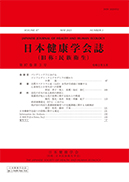Volume 87, Issue 1
Displaying 1-4 of 4 articles from this issue
- |<
- <
- 1
- >
- >|
Foreword
-
Article type: editorial
2021 Volume 87 Issue 1 Pages 1-2
Published: January 31, 2021
Released on J-STAGE: February 26, 2021
Download PDF (588K)
Original Article
-
A systematic review of food frequency questionnaire developed for Japanese and examined the validityArticle type: research-article
2021 Volume 87 Issue 1 Pages 3-14
Published: January 31, 2021
Released on J-STAGE: February 26, 2021
Download PDF (740K)
Materials of Reference
-
Article type: research-article
2021 Volume 87 Issue 1 Pages 15-26
Published: January 31, 2021
Released on J-STAGE: February 26, 2021
Download PDF (747K) -
Article type: research-article
2021 Volume 87 Issue 1 Pages 28-40
Published: January 31, 2021
Released on J-STAGE: February 26, 2021
Download PDF (915K)
- |<
- <
- 1
- >
- >|
